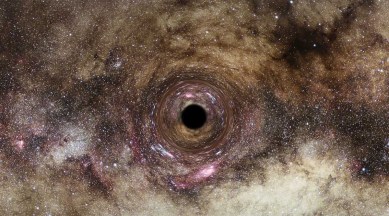One of the biggest known black holes discovered due to its light-bending gravity
An ultramassive black hole 30 billion times the mass of our Sun—one of the biggest ever found—was discovered due to a phenomenon known as gravitational lensing.

Astronomers have discovered one of the biggest black holes ever found, thanks to something called gravitational lensing.
Gravitational lensing is the name given to the phenomenon where a foreground object—a galaxy or a black hole—bends the light from a more distant object behind it, magnifying it in the process.
When the researchers included an ultramassive black hole in one of the simulations, the path taken by the light exactly matched the path seen in actual images captured by the Hubble Space Telescope
This helped them discover the ultramassive black hole, over 30 billion times the mass of our Sun, in the foreground galaxy. According to the University of Durham, this is a scale that is rarely ever seen by astronomers.
The results of the research are published in the journal Monthly Notices of the Royal Astronomical Society.
“This particular black hole, which is roughly 30 billion times the mass of our Sun, is one of the biggest ever detected and on the upper limit of how large we believe black holes can theoretically become, so it is an extremely exciting discovery,” said James Nightingale, lead author of the research, in a press statement. Nightingale is a professor at Durham University’s Department of Physics.
According to Nightingale, most of the black holes that we know about are in an active state. If a black hole is in an active state, it pulls in matter from its surroundings, heating it up and releasing energy in the form of light, X-rays and other radiation.
This new approach taken by the researchers could make it possible to study inactive black holes in distant galaxies, which is not currently possible with other existing techniques.